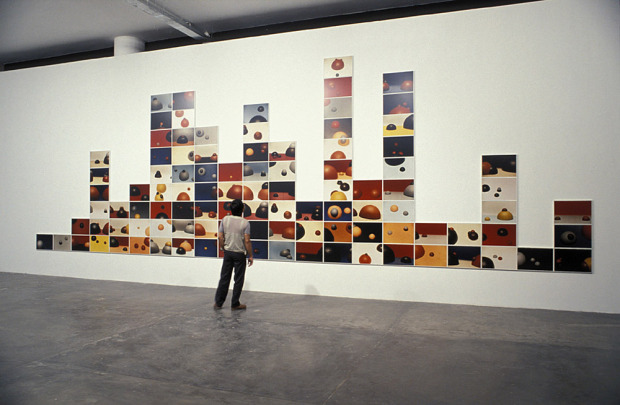Gavin Hipkins: The Colony, ex. cat. (Auckland: Gus Fisher Gallery, 2002).
Photographer Gavin Hipkins is fascinated by botched utopias. He is known for creating massive works from dozens upon dozens of similar images. The subject matter is typically banal, pointedly inconsequential—strips of plasticine, lengths of liquorice, polystyrene balls—but, repeated, massed, and marshaled, the cumulative effect is monumental and pulsing. Mimicking the heroic rhetoric of state engineering projects, Hipkins gives these works suggestive portentous titles: The Tunnel, The Field, The Circuit, The Coil, The Track, The Mill.
Hipkins’s retro-modernist arrangements hark back to a time when photography’s new ways of seeing were optimistically linked to a new vision of the modern world aligned with both progressive social programmes (Rodchenko and Moholy-Nagy) and fascist ones (Riefenstahl). Equally, they look to the present, to our current vogue for a modernist style evacuated of social concern and specificity—the style of Wallpaper magazine. Hipkins takes us to the heart of photography’s complicity, its ability to spectacularise and obscure the world in the name of delivering it. He works the space between the medium’s evidential force and its potential for abstraction, its ability to beautify—its propaganda power.
Hipkins files his new work The Colony under science fiction, the genre that looks back and forth, framing retro-politics as brave new worlds. He shot one hundred photographs of hemispherical polystyrene blobs. The individual images are crude, slipping in and out of focus. Geometric yet organic, the blobs resemble at once alien pods, igloos, pup tents, breasts, the curvaceous hills and mud pools of his native New Zealand, and bacteria. The psychedelic colour scheme is both candied and toxic; we could be staring into a lava lamp, perhaps furthering a boudoir subtext. There’s no reference for scale. The work could imply a macroscopic view (an imperialist invasion, a commune of hippie drop-outs in their geodesic domes, or a high-tech off-world encampment on a weirdly hued planet) or a microscopic one. The photos are stacked at random like a bar graph or a high-rise city skyline, as if anticipating the colony’s future order. Hipkins runs all possibilities at once. Nothing much is specified, but all possibilities are keyed to a sense of ecstatic viral replication.
The Colony goes to work on the viewer, dazzling the eye with its rhythmic prospects rather than addressing the privations and violence we know to be inherent in the colonial adventure. If at first glance it looks like an advertisement, recalling the idyllic scenes that enticed New Zealand’s first European settlers, in no time it comes to seem unstable, tinged with menace, a little creepy. If Hipkins offers us something formal looking and alluring—eye candy—he does so to evoke precisely what’s missing, what’s latent. Revving up the rhetoric of modernist photography, The Colony is haunted by what it elides: hygienic modernity crosses over into disease, science fiction into horror.
